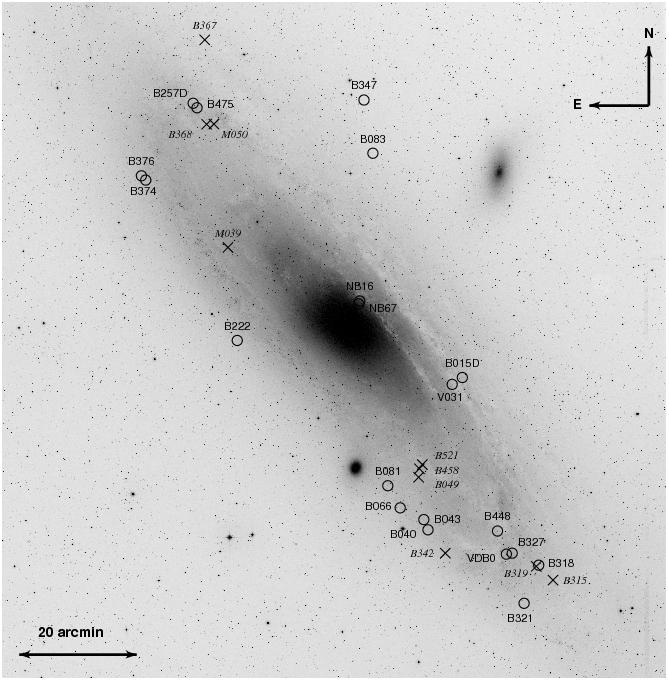| B015D | B327 |
| B040 | B347 |
| B043 | B374 |
| B066 | B376 |
| B081 | B448 |
| B083 | B475 |
| B222 | NB16 |
| B257D | V031 |
| B318 | VdB0 |
| B321 |
COMPLETENESS DATA
F450W PC FIELD IMAGES (10"x10")

|
ABSTRACT
Aims. We present the main results of an imaging survey of possible Young Massive Clusters (YMC) in M31 performed with the Wide Field and Planetary Camera 2 (WFPC2) on the Hubble Space Telescope (HST), with the aim of estimating their age and their mass. We obtained shallow (to B∼ 25) photometry of individual stars in 19 clusters (of the 20 targets of the survey). We present here the images and color magnitude diagrams (CMDs) of all of our targets. Methods. Point spread function fitting photometry of individual stars was obtained for all the WFPC2 images of the target clusters and the completeness of the final samples was estimated using extensive sets of artificial stars experiments. The reddening, the age and the metallicity of the clusters were estimated by comparing the observed CMDs and luminosity functions with theoretical models. Stellar masses were estimated by comparison with theoretical models in the log(Age) vs. absolute integrated magnitude plane, using ages estimated from our CMDs and integrated J, H, K magnitudes from 2MASS-6X. Results. Nineteen of the twenty surveyed candidates were confirmed to be real star clusters, while one turned out to be a bright star. Three of the clusters were found not to be good YMC candidates from newly available integrated spectroscopy and were in fact found to be old from their CMD. Of the remaining sixteen clusters, fourteen have ages comprised between 25 Myr and 280 Myr, two have ages larger than 500 Myr (lower limits). Including ten other YMC with HST photometry from the literature we have assembled a sample of 25 clusters younger than 1 Gyr, having mass ranging from 0.6 × 104M⊙ to 6 × 10^4M⊙, with an average of ∼ 3 × 10^4M⊙. Our estimates of ages and masses are in good agreement with recent independent studies based on integrated spectra. Conclusions. The considered clusters are confirmed to have masses significantly larger than Galactic Open Clusters in the same age range. Our analysis indicates that YMCs are relatively common in all the largest star-forming galaxies of the Local Group, while the lack of YMC older than 20 Myr in the Milky Way may be due to selection effects. |
README
COMPLETENESS DATA F450W PC FIELD IMAGES (10"x10") |
 |